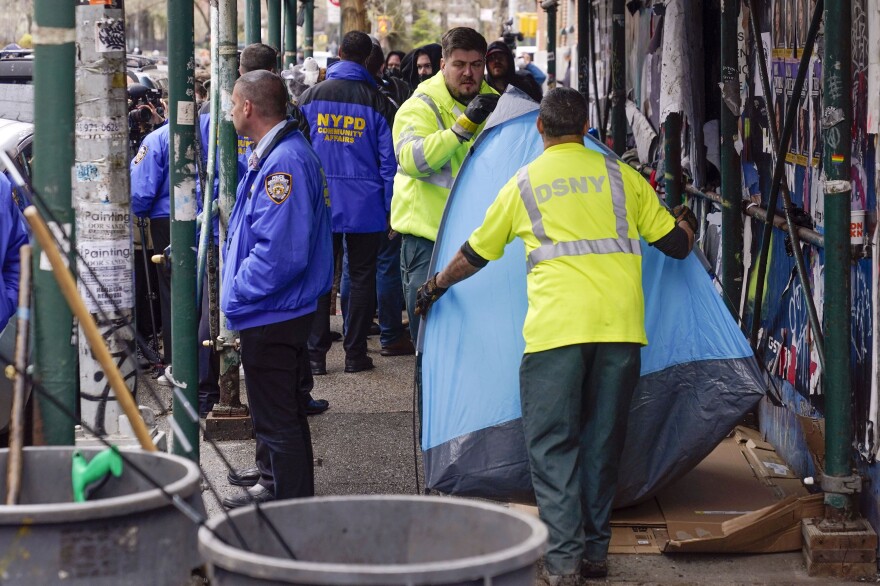
Months into his first term in office, New York City Mayor Eric Adams is touting early progress in his administration's effort to clear the streets of homeless encampments.
"I have said since we started this initiative that every New Yorker deserves dignity, and we are demonstrating that this is possible," Adams said in an emailed statement.
The administration's goal is to put homeless New Yorkers on a path to permanent housing and stability, as part of the broader plan to improve public safety. The mayor's office pointed to the latest encampment sweep numbers as a sign that he is following through on his promises.
But homeless advocates say the approach is a return to misguided tactics. They argue that the policing-focused strategies the city is using to persuade people to go to shelters in fact perpetuate the decades-long crisis.
"All they're doing is doubling down on a failed policy," said Jacquelyn Simone, policy director at the NYC-based Coalition for the Homeless. "Policing and criminalization are not the responses to what is fundamentally a housing and mental health crisis."
Homelessness in New York City is at its highest levels since the 1930s, during the Great Depression, according to the Coalition for the Homeless. Each night, more than 48,000 homeless people sleep in the city's shelter system, as of February.
Thousands of unsheltered homeless people each night sleep outdoors or in subway stations, according to the organization.
The city carried out 733 cleanups over six weeks
From March 18 to May 1, the city carried out 733 cleanups across five boroughs — a number that includes multiple visits to the same sites — according to data sent to NPR by the mayor's office. After engaging with 264 people, 39 of them accepted temporary housing.
Advocates say the number of people placed in shelters as the result of such encampment sweeps make up a small fraction of those who enter municipal shelters willingly.
Simone calls the encampment sweeps a massive waste of resources that could instead be used to address the critical needs of the homeless population.
"It's much more politically expedient to surge police officers to push people out of sight rather than to actually address the root causes," she said. "The reality is that the people who are on the streets often have tried the city's main shelter system, especially in congregate shelters, and did not feel safe there, did not feel that those facilities met their needs. So, trying to force people back into a shelter system that many have made a conscious decision to avoid is not going to be successful."
The multi-agency initiative sends out NYPD officers and workers from the city's sanitation and homeless services departments to conduct the sweeps. Residents at the encampment sites are given a 24-hour notice for the scheduled cleanups, according to city officials. The sweeps have led to the arrests of homeless activists.
Adams said in an emailed statement: "Our teams are working professionally and diligently every day to make sure that every New Yorker living on the street knows they have a better option while ensuring that everyone who lives in or visits our city can enjoy the clean public spaces we all deserve."
Advocacy groups for the homeless say what Adams calls a "better option" is far from it. At the municipal shelters there are strict curfews and shared rooms — a risky environment during the COVID-19 pandemic.
"It really functions as an extension of the prison system," said Karim Walker, an outreach specialist at Human.nyc who works closely with homeless New Yorkers. "There's very little privacy, not much in terms of accounting for your welfare" and "a boatload of regulations that a lot of people find kind of grating," he said.
Advocates say they want to see permanent housing investment
Simone, of the Coalition for the Homeless, said the city's policing-focused approach not only doesn't work — it's counterproductive.
The sweeps, she said, "make it harder for trained outreach workers to establish trust with people so that they could come indoors, because its outreach teams are only seen as a branch of the police."
If people are repeatedly displaced, she added, that also complicates the efforts of social services professionals to gain their trust.
Advocates want to see policies that invest in permanent housing.
"That's really where the administration's focus should be — not on this show of force," Simone said. "Trying to force people back into a shelter system that many have made a conscious decision to avoid is not going to be successful."
Last month, Mayor Adams said new funding would go toward alternative shelter beds, including safe haven and stabilization beds. Those options usually offer smaller-occupancy rooms and fewer rules, including no curfews.
Safe haven and stabilization programs are "synonymous to a certain degree," said Walker of Human.nyc, but safe haven facilities tend to allow longer-term stays — up to a year in some cases. Beyond permanent housing, advocates say safe haven and stabilization programs are the next best available option for people who are homeless.
But the demand for these specialized beds is greater than the supply, according to the Coalition for the Homeless; about 2,500 stabilization and safe haven beds are often occupied, with thousands of New Yorkers left sleeping outside. Adams' pledge would increase the number of alternative shelter beds to 4,000.
To give sheltered homeless people a "modicum of privacy," Walker says that no more than three people should occupy a room.
Dave Giffen, the executive director of the coalition, said in a statement that the new funding is a "small partial step" in the right direction.
"In the absence of a comprehensive plan to create vastly more permanent affordable and supportive housing, one that respects the dignity of all New Yorkers without homes, these piecemeal efforts are destined to do nothing more than kick the can down the road," Giffen said.







